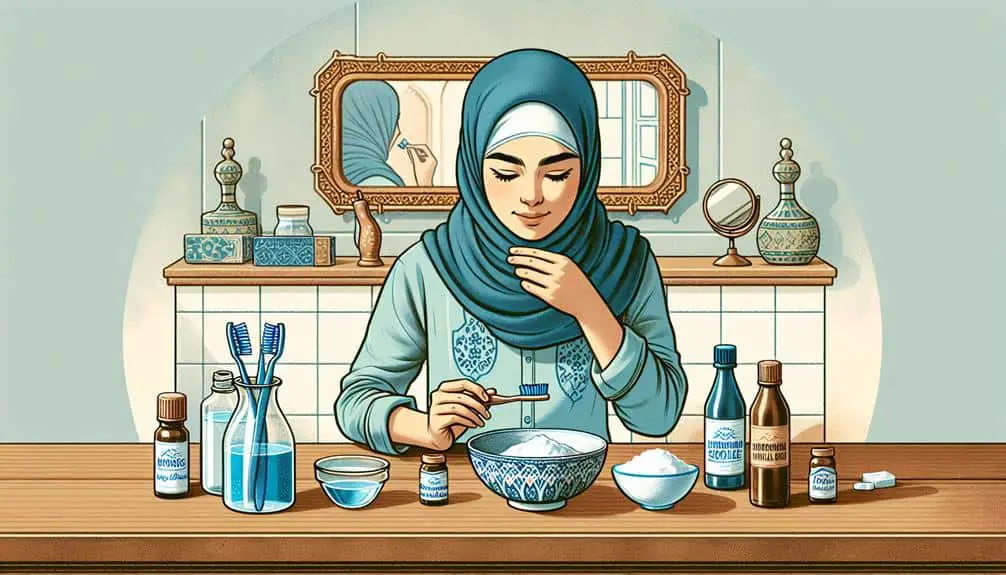Achieve a whiter smile affordably at home by understanding factors like diet, lifestyle, and oral hygiene that can cause tooth discoloration. Consider making your DIY whitening toothpaste by combining baking soda with hydrogen peroxide, proven to reduce stains over time. Embrace natural remedies such as fruit peels and coconut oil for their teeth-whitening properties. Remember to follow best practices like using whitening strips correctly and maintaining a consistent oral care routine. These tips can help you on your journey to a brighter smile without breaking the bank.
Key Points
- Use homemade whitening toothpaste with baking soda and peroxide.
- Try natural remedies like fruit peels, oil pulling, and charcoal.
- Follow proper instructions when using whitening strips.
- Maintain oral hygiene with daily brushing and flossing.
- Limit staining foods and beverages to preserve whiter teeth.
Understanding Discolored Teeth
If your teeth have lost their natural whiteness, it may be due to various factors such as diet, lifestyle choices, or dental hygiene habits. Discoloration can result from consuming staining substances like coffee, tea, or red wine, as well as from smoking. Poor oral hygiene, such as inadequate brushing and flossing, can also lead to the buildup of plaque and tartar, which can cause teeth to appear yellow or discolored. Additionally, certain medications like tetracycline can affect the color of your teeth during development.
Prevention of tooth discoloration involves maintaining good oral hygiene practices, including brushing your teeth at least twice a day and flossing regularly. Avoiding or reducing the consumption of foods and drinks that stain teeth can also help prevent discoloration. Regular dental check-ups and professional cleanings are essential to remove plaque and tartar buildup that can lead to yellowing of the teeth. Remember, understanding the causes of tooth discoloration is the first step towards achieving a brighter, whiter smile.
DIY Whitening Toothpaste Recipe
To effectively address tooth discoloration and enhance your smile at home, consider creating your own DIY whitening toothpaste using simple ingredients. Homemade treatments offer a budget-friendly alternative to commercial whitening products. One popular recipe involves mixing baking soda with hydrogen peroxide to form a paste. Baking soda is mildly abrasive and can help scrub away surface stains on teeth, while hydrogen peroxide is a bleaching agent that can lighten tooth discoloration.
To make this DIY whitening toothpaste, start by combining two tablespoons of baking soda with one tablespoon of hydrogen peroxide in a small bowl. Stir the mixture until it forms a smooth paste. You can also add a few drops of peppermint oil for a fresh flavor. Brush your teeth with this paste for about two minutes, making sure to cover all surfaces. Be cautious not to swallow the mixture, and rinse your mouth thoroughly after brushing.
Using this homemade remedy consistently can help reduce tooth discoloration and brighten your smile over time. Remember to consult your dentist before trying any DIY treatments to confirm they're suitable for your dental health.
Natural Teeth Whitening Remedies
Consider incorporating natural teeth whitening remedies into your oral care routine to achieve a brighter smile using gentle, alternative methods. Fruit peels, such as those from oranges or bananas, contain natural compounds like d-limonene and potassium that can help whiten teeth. Rubbing the inside of these peels against your teeth for a few minutes before brushing can assist in removing surface stains.
Oil pulling is another technique where swishing oil around in your mouth helps remove bacteria and stains. Coconut oil is commonly used for this purpose due to its pleasant taste and potential antibacterial properties.
Charcoal toothpaste, though black in color, can be effective in removing stains from the surface of teeth. It works by adsorbing compounds that cause discoloration. Baking soda is a mild abrasive that can gently scrub away stains when used in moderation.
These natural remedies provide alternatives to chemical-based whitening products and can be integrated into your daily oral care regimen for a brighter, whiter smile.
Best Practices for At-Home Whitening
Implementing proper techniques for at-home whitening can help you achieve a brighter smile effectively and safely. When using whitening strips, it's crucial to follow the instructions carefully to avoid damaging your teeth or gums. Make sure your teeth are clean and dry before applying the strips evenly across the front surface of your teeth. Avoid leaving them on for longer than recommended to prevent sensitivity or irritation.
Additionally, baking soda can be used as a gentle abrasive to help remove surface stains on your teeth. You can create a paste by mixing a small amount of baking soda with water and brushing your teeth with it for about two minutes. Remember not to use baking soda too frequently as it can wear down your enamel over time.
Maintaining Your Brighter Smile
For maintaining your brighter smile, it's important to establish a consistent oral care routine that includes daily brushing and flossing. Oral hygiene plays a vital role in preserving the whiteness of your teeth. In addition to regular brushing and flossing, here are some key tips to help you maintain your bright smile:
- Use a Whitening Toothpaste: Opt for a toothpaste formulated to help maintain whiter teeth.
- Limit Staining Foods and Beverages: Reduce consumption of coffee, tea, red wine, and other foods known to stain teeth.
- Drink Water After Meals: Rinse your mouth with water after consuming foods that may stain your teeth.
- Chew Sugar-Free Gum: Chewing gum can help stimulate saliva production, which aids in keeping teeth clean.
- Schedule Regular Dental Checkups: Dental checkups are essential for professional cleaning and early detection of any oral health issues.
Frequently Asked Questions
Are There Any Specific Foods or Drinks That Can Help Prevent Teeth Discoloration?
To prevent teeth discoloration, focus on a healthy diet rich in fruits and vegetables. Hydration benefits oral health. Incorporate foods like apples, carrots, and celery, which can help clean teeth naturally. Avoid excessive consumption of staining agents like coffee and tea.
Can Using Whitening Toothpaste Too Frequently Damage Tooth Enamel?
Brushing with whitening toothpaste excessively is like polishing a fragile antique vase too vigorously. While it can enhance your smile, overuse poses enamel protection risks and may lead to tooth sensitivity. Moderation is key.
How Long Does It Typically Take to See Results From Natural Teeth Whitening Remedies?
Results from natural teeth whitening remedies vary. Some may show improvement in a few weeks, while others may take months. Consistent use is key. While generally safe, be mindful of potential long-term effects on enamel from frequent home whitening treatments.
Are There Any Potential Risks or Side Effects Associated With At-Home Whitening Treatments?
When considering at-home whitening treatments, it's important to be aware of potential risks and side effects. These may include tooth sensitivity, gum irritation, and uneven whitening. Consult a dentist for personalized advice and safe usage.
Is It Recommended to Consult With a Dentist Before Starting Any At-Home Teeth Whitening Regimen?
Before embarking on any at-home teeth whitening regimen, it's recommended to consult with a dentist. This step guarantees you select safe whitening products, tackle teeth discoloration effectively, and take preventive measures customized to your oral health needs.
Conclusion
Now that you have learned budget-friendly tips for whiter teeth at home, remember to be consistent in your oral care routine for the best results.
For example, Sarah, a busy mother of two, saw noticeable improvements in her smile after using the DIY whitening toothpaste recipe for just two weeks.
By incorporating these tips into your daily routine, you too can achieve a brighter smile without breaking the bank.


